Анархизм в Аргентине
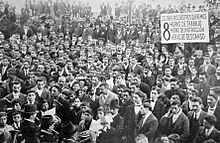
Аргентинское анархистское движение было самым сильным таким движением в Южной Америке . [ 1 ] Это было самым сильным между 1890 году и началом серии военных правительств в 1930 году. В течение этого периода доминировали анархистские коммунисты и анархо-синдикалисты . Теории движения были гибридом европейской анархистской мысли и местных элементов, так же, как оно было демографически как из европейских работников иммигрантов, так и местных аргентинцев. [ 2 ]
Ранние годы
[ редактировать ]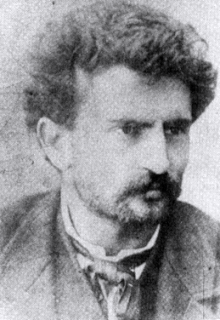
Первые аргентинские анархистские группы появились в 1870 -х годах. Секция первого интернационала была основана в аргентинской столице Буэнос -Айреса в 1871 или 1872 годах, но сначала она явно была частью ни анархиста, ни его марксистского крыла. К 1879 году в Аргентине было несколько разделов, с анархистами, контролирующими их всех. В 1876 году приверженцы идеалов Бакунина основали Центр пропаганды рабочих. В 1879 году Эль -Дисамисадо стал первой анархистской газетой в стране. [ 3 ] [ 4 ] Хорошо известный итальянский анархист Эррико Малатета был в Аргентине с 1885 по 1889 год. С его помощью в 1887 году был начат первый анархистский профсоюз: Космополитическое общество сопротивления и размещения пекарей . В 1890 году еще один анархистский орган, которого преследуют, начал свою публикацию. [ 5 ] [ 6 ]

В течение этого времени аргентинское анархистское движение было разделено на вопрос организации. Был, в основном коммунистические анархисты , организации работников, которые были склонны к естественному оружию для анархистской борьбы. Противники организаций, как коммунистических, так и индивидуалистических анархистов , в свою очередь утверждали, что организации заставили тех, кто работает внутри них, стать реформистами и отказаться от своей революционной позиции. До своего отъезда в 1889 году Малатеста помог преодолеть этот разрыв и минимизировать напряженность и соперничество между двумя крыльями, но после того, как он ушел, они снова разразились. [ 7 ] Проорганизаторы были укреплены в 1891 году прибывающими испанского анархиста Антони Пеллисер в 1891 году и итальянской Пьетро Гори в 1898 году. В 1897 году сторонники профсоюзов также основали еженедельную газету La Protesta Humana . В 1900 году Paraire опубликовал серию статей в La Protesta Humana под названием «Организация труда», выступающая за концепцию двойной организации: федерация воинственной труда для экономики и действительно анархистская организация по политическим вопросам. [ 2 ]
Основа и радикализация FORA
[ редактировать ]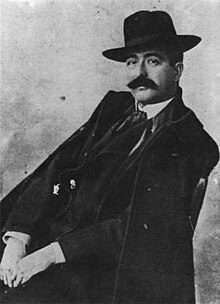
Аргентины В 1901 году была основана первая национальная конфедерация лейбористской партии , Федерация аргентинских рабочих (FOA). Хотя его основополагающие принципы находились под влиянием Paraire и Gori, сначала это был совместный проект с социалистами. В 1902 году произошел первый всеобъемлющий удар по аргентинской истории. Это привело к принятию Закона о проживании , который дал правительству полномочия депортировать «подрывных иностранцев». Этот закон использовался для изгнания сотен анархистов, [ 8 ] в то время как многие из них бежали в Монтевидео в Уругвае, только чтобы вернуться в страну впоследствии. [ 9 ] В 1903 году La Protesta Humana была переименована в протесту LA , название под ним, которое существует и по сей день. [ 5 ] В том же году умеренное крыло FOA покинуло Федерацию, чтобы сформировать союз общих работников (UGT), оставив гегемонию в FOA анархистам. Они переименовали Союз как аргентинскую региональную федерацию работников (FORA) как признак интернационализма организации в 1904 году. В 1905 году на пятом конгрессе Фора его приверженность анархизму была формализована. В резолюции он заявил, что он должен «привить работникам экономические и философские принципы анаркокоммунизма». [10] This resolution became the basic policy for the following years. The FORA disagreed with the revolutionary syndicalists over the question of the unions' role after a revolution. While the anarcho-communists viewed labor unions as a by-product of capitalist society, which would have to be dissolved with the establishment of an anarchist society, the syndicalists viewed their unions' democratic structure as a model for the society they envisioned and wanted the unions to be the basis of such a new society.[11] A series of strikes, many of them instigated by the anarchists, followed in 1905.[2]
During this period the anarchist movement experienced rapid growth. 50 to 70% of the males in the working class were disenfranchised, because they were not native Argentines. Hence the legal political framework was not an option for them and anarchism gained appeal.[12] The movement's strength and its relationship to the state is demonstrated by the events on May 1, 1904. 70,000 anarchist workers marched in the streets of La Boca (Buenos Aires' total population was of 900,000). Proscribed by Roca's government, the demonstration ended in the death of Juan Ocampo, a teenager.[13]
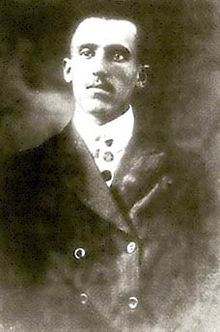
Major clashes with police
[edit]In 1909, police fired on a May Day demonstration in the Plaza Lorea in Buenos Aires organized by FORA. Several workers were killed. The anarchists responded by declaring a general strike leading the government to shut down the workers' centers and arrest 2,000 people. This strike lasted nine days. As the Chief of Police Ramón Falcón was widely blamed for the killing, the young Jewish anarchist Simón Radowitzky killed him and his secretary by throwing a bomb at the car they were in on November 13. An unprecedented repression against the anarchist movement ensued. Martial law was declared and remained in place until January 1910. The offices of La Protesta were raided and its machinery destroyed, as were the workers' centers. Within 48 hours thousands were arrested, many sent to Ushuaia prison in Tierra del Fuego. Non-Argentine activists were generally deported.[14]
Although martial law was lifted in January 1910, this year also saw the next major clash between the government and the anarchists. 1910 was the hundredth anniversary of the May Revolution of 1810, which led to Argentine independence. Anarchist agitation was on the rise, a new anarchist daily newspaper, La Batalla, was founded in March,[15] and the FORA planned protests against the Residence Law, but was somewhat hesitant as it scented a lack of militancy among workers. The moderate syndicalist Argentine Regional Workers' Confederation (CORA), the successor of the General Workers' Union, however, pushed for confrontation and the anarchists were forced to follow suit. They threatened to call for a general strike on May 25, the day of the anniversary festivities. Therefore, the government once again declared martial law on May 13. Police arrested the editors of La Protesta and La Batalla and FORA leaders. Meanwhile, right-wing militant youths attacked union offices and workers' clubs while the police ignored or even encouraged them. Because of this, the general strike was moved to May 18, but it was suppressed by the police and the right-wing militants.[2][16] 1910 also saw the sentencing of Simón Radowitzky. As a minor, he could not be sentenced to death, so he was condemned to life in Ushuaia. He would be pardoned and released from prison in 1930.[16][15]
Argentine anarchist historian Ángel Cappelletti reports that in Argentina "Among the workers that came from Europe in the 2 first decades of the century, there was curiously some stirnerian individualists influenced by the philosophy of Nietzsche, that saw syndicalism as a potential enemy of anarchist ideology. They established...affinity groups that in 1912 came to, according to Max Nettlau, to the number of 20. In 1911 there appeared, in Colón, the periodical El Único, that defined itself as 'Publicación individualista'".[17]
FORA split
[edit]The events of 1909 and 1910 left the Argentine anarchists fatigued. The movement's growth stalled as a result of state repression and the country's economic problems.[2] The Law of Social Defense, passed as a reaction to the Falcón assassination, allowed the government to deny any foreigner who committed crimes punishable under Argentine law entry into the country, prohibited the entry of anarchists, banned groups disseminating anarchist propaganda, and granted local authorities the power to prohibit any public meetings which subversive ideas could be expressed at.[18]
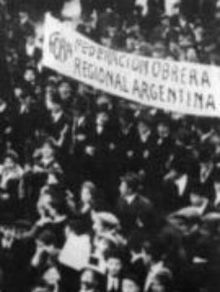
Meanwhile, the moderate syndicalist CORA grew in size as a result of its pragmatic approach, which included participating in negotiations with employers in place of direct action as advocated by the anarchists. Striving for labor unity, the CORA set up a fusion committee with some non-affiliated unions to push for a merger with the FORA. The majority of the FORA agreed, calling for the CORA to abolish itself and enter the FORA. At the April 1915 FORA congress, its ninth, a resolution which reversed its commitment to anarchist communism was passed, paving the way for the CORA unions to join. Only a minority in the FORA rejected this move. After the congress, this minority started a breakaway federation under the name FORA V, referring to the fifth congress, which the resolution for anarcho-communism was passed at. While the FORA IX had somewhere between 100,000 and 120,000 members, the anarchist FORA V had 10,000 at the most, though both figures are considered unreliable. The FORA V was strongest in the interior of the country, where most of the workers were native Argentines.[2][19]
With the start of World War I in 1914, the conditions for the anarchist movement became even more unfavorable. The falling of wages and a net migration back to Europe created poor premises for any kind of labor activism and the anarchist FORA V struggled to adapt to this. After a railworkers' strike broke out in October 1917, the anarchists called for a futile general strike and received little support from the FORA IX. A meat-packers' strike in Berisso and Avellaneda led by the anarchists was defeated in 1918.[20]
Semana Trágica and 1920s
[edit]In December 1918, a strike broke out at the Vasena metalworks in the Buenos Aires suburbs of Nueva Pompeya. The union leading the strike was a splinter from FORA IX and called itself anarchist, though its links to FORA V were tenuous. On January 7, 1919, a shootout between strikers and police, troops, and firemen killed five. The police and troops then attacked the 200,000 workers at the funeral procession on killing at least thirty-nine and injuring many more. After the events of January 7, the FORA V immediately called for a general strike, but the work stoppage that followed was more of a result of the workers' outrage over the killings than of the anarchists' call. The general strike took place on January 11 to 12, but then subsided. Once again, the police, the military, and right-wing groups reacted with pogroms in working-class neighborhoods. Right-wing militants created the Argentine Patriotic League. The Jewish inhabitants of the workers' quarters especially became the victims of the attacks. In all, somewhere between 100 and 700 people died and around 4,000 were injured. The Semana Trágica further perpetuated the decline of Argentine anarchism. From around 1920 on, the anarchists' influence in the trade unions was rather minor.[21][2]
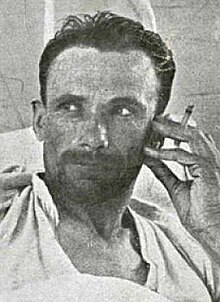
From 1920 to 1922, there was a peasant uprising in Patagonia led by anarchists. The army, led by Colonel Héctor Varela, reacted by executing some 1,500 people. Because of the remoteness of the region, the events did not become known in Buenos Aires at first. Once they did, the anarchist movement started a campaign against the "killer of Patagonia", as they called Varela. This led the Tolstoyan anarchist Kurt Gustav Wilckens to assassinate the colonel on January 23, 1923.[2][22]
The movement's decline continued nevertheless. It was intensified by both strife within the movement and government persecution.[2]
The rise of Argentine pistolero in the 1920s saw an increase in bombings and expropriations, though denounced by other anarchist leaders. Anarchists like Miguel Roscigna and Severino Di Giovanni engaged in expropriations affiliated with the criminal world to fund the social revolution, publishing, and political prisoners. Expropriative anarchism peaked in the late 1920s and was suppressed after the 1930 military coup.[23]
Infamous Decade and Perón government
[edit]On September 6, 1931, José Félix Uriburu came to power in Argentina via a coup d'état starting a series of military governments known as the Infamous Decade. The anarchist FORA, the sole FORA since the FORA IX was renamed as the Argentine Syndicates' Union (USA) in 1922, went underground immediately. A number of distributors of La Protesta were arrested or killed within a year of Uriburu's ascension to power. Deciding it had become impossible to distribute the paper, the publishers of La Protesta ceased making it and disseminated an underground newspaper named Rebelión instead. After martial law was lifted in 1932, La Protesta, the anarchist weekly La Antorcha, and FORA unions in Santa Fe and Rosario published a manifesto called "Eighteen Months of Military Terror" about the repression they had endured. In this year the second Regional Anarchist Conference was held in Rosario - the first having taken place in Buenos Aires in 1922. It had been planned by anarchists imprisoned under Uriburu. The congress set up a regional committee for anarchist co-ordination, which eventually led to the founding of the Argentine Anarcho-Communist Federation (FACA) in 1935.[24]
The Spanish Civil War, which broke out in 1936, was an important topic for the Argentine anarchists. Various anarchists left to fight in the war and the FACA's official newspaper Acción Libertaria published special editions dedicated to it.[25]
In 1946, President Juan Perón came to power. With the emergence of Peronism, more and more labor unions (especially the socialist ones) became Peronist, and anarchist unions - which had already suffered a significant decline during the previous decade - lost all of their remaining strength. The anarchist representation in the labor movement became minimal. When Peronism became the mainstream ideology of the Argentine working people, it replaced the old mainstream labor ideologies (including anarchism, socialism and communism), which never again regained their old importance among the working class.[26] FORA, the traditional anarchist union, was closed as a result of this. In 1952, following the imprisonment and torture of several FORA members, anarchists of all factions launched a campaign to inform the public of this situation. After the violent coup that overthrew Perón in 1955, anarchist periodicals reappeared openly once again, among them La Protesta and Acción Libertaria. However, Argentine anarchism could never recover as a movement with popular roots.[27]
More recent developments
[edit]The FACA became the Argentine Libertarian Federation (FLA) in 1955, but like its predecessor organization was never able to gain a mass following. In 1985, the FLA replaced its newspaper Acción Libertaria with a new political journal called El Libertario.[28][29]
The Rosario-based Columna Libertaria Joaquin Penina celebrated May Day in 2008.[30][31]
In 2010, the Anarchist-Communist Federation of Argentina (FACA) was established by 3 groups: the Columna Libertaria Joaquin Penina from Rosario, the Columna Libertaria Errico Malatesta from the city of Buenos Aires, and the Columna Libertaria Buenaventura Durruti from the west of the Greater Buenos Aires.[32] Its main fronts of public social struggles were the unionized and the unemployed worker movements. Its ideology was revolutionary socialist and specifism. Although it shares the name with an anarchist organization from the 1930s, it's not considered as a continuation of it. Its public appearances emphasize the comeback of a "committed social anarchism."[33]
See also
[edit]- Category:Argentine anarchists
- List of anarchist movements by region
- Horizontalidad
- Socialism in Argentina
- December 2001 riots in Argentina
- FaSinPat
- Brukman factory
- Hotel Bauen
References
[edit]- ^ Simon 1946, p. 38
- ^ Jump up to: a b c d e f g h i Oved 1997
- ^ Moroziuk, Lidia (2007). "Inmigración e ideología anarquista. Protesta agitativa contrainstitucional y gráfica contestataria (1879 – 1940)" (PDF). VII Jornadas de Sociología, Facultad de Ciencias Sociales, Universidad de Buenos Aires, Buenos Aires.
- ^ Oved, Iaacov (1978). El anarquismo y el movimiento obrero en Argentina. p. 22.
- ^ Jump up to: a b Colombo 1971, pp. 215–216
- ^ Simon 1946, p. 39
- ^ Colombo 1971, p. 216
- ^ Thompson 1990, p. 168
- ^ Simon 1946, p. 42
- ^ Thompson 1990, pp. 168–169
- ^ Colombo 1971, pp. 217–18
- ^ Colombo 1971, p. 227
- ^ Bayer, Osvaldo (4 June 2006). "Después de anoche, sólo me queda Marlene". Página/12 (in Spanish). Buenos Aires.
- ^ Colombo 1971, pp. 218–219
- ^ Jump up to: a b Colombo 1971, p. 219
- ^ Jump up to: a b Simon 1946, p. 44
- ^ Rama, Carlos M.; Cappelletti, Ángel J. (1990). El Anarquismo en América Latina (in Spanish). Fundacion Biblioteca Ayacuch. p. CLVII. ISBN 9802761168. OCLC 925976471.
- ^ Simon 1946, pp. 44–45
- ^ Thompson 1990, pp. 173–174
- ^ Thompson 1990, p. 174
- ^ Thompson 1990, pp. 175–176
- ^ Colombo 1971, pp. 219–220
- ^ * Caimari, Lila (2017). While the City Sleeps: A History of Pistoleros, Policemen, and the Crime Beat in Buenos Aires Before Perón. University of California Press. pp. 38–39. ISBN 978-0-520-28943-7.
- ^ Colombo 1971, pp. 220–221
- ^ Colombo 1971, p. 221
- ^ Rama, Carlos M.; Cappelletti, Ángel J. (1990). El Anarquismo en América Latina (in Spanish). Fundacion Biblioteca Ayacuch. p. XLIII. ISBN 9802761168. OCLC 925976471.
- ^ Colombo 1971, pp. 221–222
- ^ Микер, Джеральд Х. (ноябрь 1974 г.). Революционер ушел в Испании, 1914-1923 . Издательство Стэнфордского университета. п. 28. ISBN 978-0804708456 .
- ^ Морс, Чак (2009). Несс, Иммануэль (ред.). «Анархизм, Аргентина». Международная энциклопедия революции и протеста : 104. DOI : 10.1002/9781405198073.wbierp0040 . ISBN 9781405198073 .
- ^ / Молодые анархисты переживут первый акт 1 мая, а также зачтенные 2009-05-08 на машине Wayback , столице
- ^ / Rock, История и опыт во время анархиста 1 мая в Лопезе Апкулировали 2012-07 на The Wayback Machine , столице
- ^ Valrmde, 30 апреля 2011 г.). "Обозвезды Хоакиин Пенинны " LA Capital (по -испански). Архивировано из оригинальности .
- ^ Stampella, Себастьян (май 2011 г.). "Росарио грех бог " Круз дель -Сур (на испанском). Архивировано из оригинала 30 июля
Библиография
[ редактировать ]- Коломбо, Эдуардо (1971), «Анархизм в Аргентине и Уругвай», в Аптер, Дэвид Э .; Джолл, Джеймс (ред.), Anarchism Today , Garden City, Нью -Йорк: Anchor Books, с. 211–244 .
- Морс, Чак (2009). «Анархизм, Аргентина». В Несс, Иммануэль (ред.). Международная энциклопедия революции и протеста . Оксфорд: Джон Уайли и сыновья. С. 1–5. doi : 10.1002/9781405198073.wbierp0040 . ISBN 978-1-4051-9807-3 .
- Oved, Яаков (1997). «Уникальность анархизма в Аргентине» . Междисциплинарные исследования в Латинской Америке и Карибском бассейне . 8 (1). Тель -Авив: Университет Тель -Авива. ISSN 0792-7061 . OCLC 25122634 .
- Саймон, С. Фанни (февраль 1946 г.). «Анархизм и анархо-синдикализм в Южной Америке». Латиноамериканский американский исторический обзор . 26 (1). Дарем: издательство Duke University Press: 38–59. doi : 10.2307/2507692 . ISSN 0018-2168 . JSTOR 2507692 .
- Томпсон, Рут (1985). «Ограничения идеологии в раннем аргентинском рабочем движении: анархизм в профсоюзах, 1890–1920». Журнал латиноамериканских исследований . 16 (1): 81–99. doi : 10.1017/s0022216x00004041 . ISSN 0022-216X . S2CID 154931932 .
- Томпсон, Рут (1990), «Аргентинский синдикализм: реформизм перед революцией», в Ван дер Линден, Марсель; Thorpe, Wayne (Eds.), Революционный синдикализм: международная перспектива , Aldershot: Scolar Press, с. 167–183, ISBN 0-85967-815-6
Дальнейшее чтение
[ редактировать ]- Стависки, Себастьян (май 2023). «Вегетарианство в риоплатенсе анархистской прессы [вегетарианство в анархистской прессе реки Ла -Плата]» . Региональный журнал истории (на испанском). 27 (2): 1–17. Doi : 10.19137/Qs.v27i2.6336 . ISSN 0329-2665 . EBSCO HOST 165033088 .
- Suriano, John (2010). Парадоксы утопии: анархистская культура и политика в Буэнос -Айресе, 1890–1 Перевод Морса, Чхук. Эдинбург; Окленд, Калифорния: AK Press. ISBN 978-1-84935-006-8 Полем OCLC 461279230 .
- Вудкок, Джордж (1986). «Различные традиции: анархизм в Латинской Америке, Северной Европе, Великобритании и Соединенных Штатах». Анархизм: история либертарианских идей и движений (2 -е изд.). Harmondsworth: книги пингвинов. ISBN 978-0-14-022697-3 Полем OCLC 489971695 .
Внешние ссылки
[ редактировать ]- История анархизма в Аргентине с форума RA
- Анархистский город Америки Сантьяго Хуан-Наварро Статья о работе Пьера Квирула
- Веб -сайт FLA (Аргентинская либертарианская федерация)
- FLA цитируется в анархистской энциклопедии
- [1] сканирование периодических изданий, размещенных в архиве FLA.